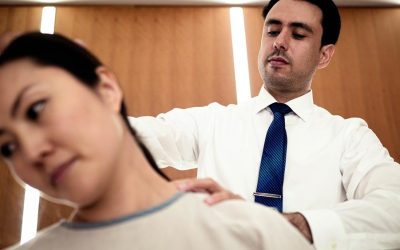Temporomandibular Joint (Jaw) specialised treatment
Book a free 15 minute consultationTemporomandibular Joint (Jaw)
The Temporomandibular joint is a complex structure made up by the temporal and the mandibular bone supported by several powerful muscles and ligaments and controlled by an intricate and extensive neurological network. Although being a small joint and usually neglected by many healthcare practitioners, the TMJ its capable of generating tremendous amount of forces per square inch, mainly produced by the strongest muscle in the body, the masseter. Due to the magnitude of forces the TMJ can generate, dysfunctions in this area can be particularly painful and debilitating for the patient, hence extreme care should be taken in the management of this joint.
TMJ disorders rarely occurs by its own, due to the spinal ascending biomechanical and neurological influences, evaluation and correction of spinal dysfunctions is paramount when dealing with TMJ dysfunctions.
The 5 TMJ defence Mechanisms is hierarchically made up by the proper Alignment of temporal and mandibular bone followed by the strength of all the Muscles involved in mastication then by the health a number of Ligaments holding the TMJ together, the proper cushion support provided by the intraarticular Disc and cartilage and by the frame support of the vertebral Bones. The extend and level of tissue damage is dependent on the number of protective layers that have been compromised from the trauma.

For instance, when the first protective Alignment layer is affected, there is a misalignment dysfunction resulting in potential jaw abnormalities as seen in malocclusion (misaligned bite) syndromes , therefore I consider Level 1 Injury as there is only one main structure that has been affected.
In cases of TMJ disc displacements injuries where the trauma impaired four layers of the protective mechanisms ( Alignment, Muscles, Ligaments and Disc), its considered Level 4 Injury as there were four layers that have been compromised allowing the biomechanical stress to end up damaging the inner structures, the Disc. In summary, there are 5 protective layers of defence and 5 corresponding Level of injuries, higher the level of injury the more substantial the number of tissue damage as per the accumulative damage that is passed from one phase to the other. (Level 5 injury means that all the previous defence mechanisms have been compromised up to the 5th layer as seen in TMJ dislocations with associated fractures).
Throughout my extensive education and clinical experience, I conclude that even though there are several named pathologies and diseases described by the traditional medicine, the origin and the predisposing factors that have lead the development of these healthcare conditions shared a similar causation and pathophysiological principle.
In addition, due to the multiple level of tissue damage often seeing in injuries there is not a single approach that is enough in order to properly managed and fully resolve the condition in question, hence I developed specific treatment protocols utilising different health care methods and techniques that eventually allowed me to efficiently resolve and heal as well as prevent the further development of future injuries.
The protocols I developed aim to properly repair and restore the entire self defence mechanism
5 Levels of TMJ injuries and the corresponding associated conditions.
Jaw Therapy
Level 1 injuries - Misalignment dysfunctions
Note: Minor joint misalignment does not create any visible deformation. Clinical assessment and X-ray imaging are paramount for diagnosing subtle joint dysfunction.
Malocclusion Syndrome, Locked TMJ, TMJ Deviated syndrome ( right or left) .
Due to the close relationship the TMJ has with the certain facial nerves, there are few neurological pain patterns that could developed form a dysfunctional misaligned TMJ.
Level 2 injuries - Misalignment - Muscle/tendon/fascia/injuries
Level 3 Injuries – Misalignment – Muscle compromised - Ligamentous injuries
Level 4 Injury - Misalignment – Muscle compromised – Ligamentous weakness - Cartilage Injury
Level 5 Injury- Misalignment – Muscle compromised – Ligamentous weakness and Cartilage damaged leading to Bone fractures
Covid 19
Covid 19Coronavirus general guidelines When visiting the clinic, we ask you to please remember these general principles to ensure we all have a good clinic experience, minimise risk and stay safe. •...
Treatment Modalities
Treatment methods I utilize in my practice to restore and enhance the healing of the entire layers of tissue injuries according to the specific healthcare conditions diagnosed.
Spine
The Spine is embedded in two important physiological principles that aids in the overall body homeostasis, The biomechanical and Neurological foundation concepts.
Wrist/Hand
The hand is considered one of the most adaptable and complexes areas in the body, there is an intricate neurological network and muscle/tendon leverages system that allows the hand to be controlled in such precision and dexterity like any other body part.
Shoulders
The shoulder is considered as one of the most complex areas in the body, there are several joints that made up the entire shoulder girdle supported by a sophisticated stabilization intrinsic
Knee
KneeThe knee is often seen as the weak link of the lower extremity as its sits between two stable joints, the ankle and the hip, therefore to accommodate this biomechanical disadvantage, there is...
Hip
HipThe hip is made up by the connection between the femur and the pelvis. There is natural physiological locking mechanism that allows this joint to be one of the most stable areas in the body. In...
Elbow
ElbowAs an extension of the shoulder mechanics, the elbow provides a great amount of versatility and freedom for the usage of the wrist and hands during daily activities adding a reliable and...















